2. 中国自然资源航空物探遥感中心, 北京 100083;
3. 自然资源部航空地球物理与遥感地质重点实验室, 北京 100083
2. China Aero Geophysical Survey and Remote Sensing Center for Natural Resources, Beijing 100083, China;
3. Key Laboratory of Airborne Geophysics and Remote Sensing Geology, Ministry of Natural Resources, Beijing 100083, China
磁性体的总磁化方向是感应磁化方向与剩余磁化方向的矢量和.在地质体剩磁较弱及自退磁效应可忽略的情况下,可假设总磁化方向与感应磁化方向一致.然而,当地质体具有较强的剩磁及自退磁效应时,这种假设将给磁法勘探的数据处理、反演及解释带来较大的误差(王妙月等,2004;Li et al., 2010; 李媛媛等,2010;刘双等, 2012, 2013; Pilkington and Beiki, 2013; Guo et al., 2014;Liu et al., 2015). 因此,当地质体具有较强的剩磁或自退磁效应时,获取地质体的总磁化方向对磁法勘探的数据处理、反演及解释具有重要意义.从磁异常本身或其转换量进行分析,进而获取总磁化方向信息,成为一种估算总磁化方向的有效方法.例如,Roest和Pilkington(1993)提出了一种2D磁源的磁异常解析信号和伪重力异常水平梯度绝对值的互相关估算方法;Dannemiller和Li(2006)提出了基于化极数据的垂直梯度及其解析信号的互相关估算方法;Nicolosi等(2006)提出了基于等效源技术的估算方法;Gerovska等(2009)提出了基于磁异常模量与化极数据的互相关估算方法;Guo等(2014)提出了基于归一化磁源强度与化极数据的互相关估算方法;Zhang等(2018)提出了基于归一化磁源强度垂向导数与化极数据的互相关估算方法.
地磁场作为一种矢量场,既有大小也有方向,其三分量矢量信息可应用于总磁化方向估算.Helbig(1963)提出了三分量磁异常一阶矩与磁源磁矩的积分关系,管志宁和李保国(1984)在此基础上提出了三分量磁异常二阶矩与磁源磁矩的积分关系,这两个重要的积分关系为采用三分量磁异常矢量数据进行磁源总磁化方向估算奠定了理论基础.Phillips(2005)基于一阶矩积分关系,以二维梯形求积近似无穷积分,采用滑动窗口的方法实现了磁源总磁化方向估算,并基于二阶矩积分关系进一步将该方法扩展到张量磁异常数据(Phillips et al., 2007);Caratori Tontini和Pedersen(2008)基于二阶矩积分关系实现了磁源中心水平位置、深度与总磁化方向估算;Foss和McKenzie(2011)讨论了Phillips(2005)方法中滑动窗口大小所产生的误差,认为在没有相邻磁异常干扰的情况下,越大的窗口估算的误差越小.窗口大小的选择以及如何减少相邻磁异常对估算结果的影响是该方法存在的主要问题(Phillips,2005;Caratori Tontini and Pedersen, 2008;Foss and McKenzie, 2011).
传统航磁测量仅测量地磁场总强度矢量的模量大小,而航磁矢量(三分量)测量则可以同时获得磁场三个分量的矢量信息.由于航磁三分量测量要求姿态传感器的测量精度较高,测量数据的误差很大程度取决于姿态仪测量姿态角的精度,在50000 nT地磁场强度的情况下,0.001°的姿态角度变化可以引起约1 nT的磁场分量误差(Munschy and Fleury, 2010).因此,以往较大的测量误差限制了直接利用三分量磁异常进行总磁化方向估算,而是以总场磁异常转换的三分量异常代替(Lourenco and Morrison, 1973; Blakely, 1995). 然而,这种基于离散2D傅里叶的转换会带来误差(Foss and McKenzie, 2011),特别是在低磁纬度地区,这种转换不稳定,并且要求测量面为平面(Blakely, 1995; Li et al., 2010; Li S L and Li Y G, 2014; Li, 2017; Xie et al., 2020). 在国家高技术研究发展计划(863计划)及国家重点研发计划的资助下,中国自然资源航空物探遥感中心自主研制了中国首套实用化航磁矢量测量系统——AGS-863航磁三分量测量系统(林君等,2017;熊盛青等,2018;熊盛青,2020).该系统分别于2016年及2018年,在大兴安岭加格达奇地区及东天山启鑫地区开展试验飞行,共获得约13897测线千米的高精度实测航磁三分量数据(Xie et al., 2020).随着系统的不断改进,目前AGS-863航磁三分量测量系统的矢量磁测噪声为2.32 nT(Behura, 2020;Xie et al., 2020).
本文基于三分量磁异常一阶矩与磁源磁矩的积分关系,讨论了不同大小滑动窗口所引起的估算误差,通过模型数据分析了估算结果中的磁化倾角、磁化偏角与实际磁源中心位置的关系,采取了根据该位置关系限定角度差值区域的方法,实现了多个磁异常情况下的总磁化方向估算.最后,采用东天山启鑫地区实测航磁三分量数据进行磁源总磁化方向估算,获得了具有强剩磁的启鑫岩体的总磁化方向,并将估算结果应用于化极计算中.
1 估算方法及磁源中心位置分析 1.1 估算方法根据三分量磁异常一阶矩与磁源磁矩的积分关系,即将分量磁异常一阶矩的积分与磁矩联系起来(Helbig,1963):

|
(1) |
其中,Bx, By, Bz分别是x, y, z方向的三分量磁异常;mx, my, mz分别是x, y, z方向的磁矩.
计算获得三个方向的磁矩后,可以进一步计算获得总磁化方向(Phillips,2005):

|
(2) |

|
(3) |

|
(4) |
其中,|m|为总磁矩模量;I, D分别为利用三分量磁异常估算的总磁化倾角及偏角.
从式(1)可知,需要沿着z平面进行无穷积分,为了方便航磁网格化数据的应用,可采用滑动的窗口进行二维梯形求积公式计算(Phillips,2005):

|
(5) |
其中,wi, j根据积分中心点的位置而选取不同的值,即当积分中心点在网格边界时,w=2;在网格四个角时,w=1;在网格内部时,w=4.Δx, Δy分别为x, y方向上的网格间距.
通过滑动窗口对整个平面数据进行积分,由式(3)、式(4)可分别获得估算的磁化倾角、磁化偏角等值线图,但是磁源的中心未知.由式(1)可知,磁矩由无穷积分确定,实际采用二维梯形求积公式计算,由有限积分近似无穷积分,当积分中心在磁源中心时,计算的磁矩误差最小;当窗口偏离磁源中心时,计算的磁矩存在偏差.因此,不同大小积分窗口的估算结果在磁源中心处最接近,由此可将不同积分窗口的结果求差,差值最小处即为磁源中心.磁源中心确定后即可从估算的磁化倾角、磁化偏角等值线图中获得估算的总磁化方向(Phillips,2005).为了增加结果的可靠性,我们同时采用磁化倾角与磁化偏角求取差值:

|
(6) |
当窗口多于两个时,可将不同窗口估算的结果两两相互求差,并取绝对值,再进行相乘获得角度的差值.窗口的大小应在尽可能避免受相邻异常影响的前提下,使用尽可能大的窗口来提供更稳定可靠的估计结果(Foss and McKenzie, 2011).该方法的前提是假设磁源均匀磁化,即具有统一的总磁化方向,且该方法易受相邻异常的影响,因此对相对孤立异常具有较好的应用效果(Li et al., 2010),同时磁异常不能具有明显的走向(Phillips,2005),且积分平面应包括尽可能完整的磁异常信息(Caratori Tontini and Pedersen, 2008).由式(1)可知,需要对磁异常进行无穷积分求得磁矩,若磁异常中包含了非磁源本身引起的趋势场,则求得的磁矩不是磁源本身的磁矩,存在误差,影响估算结果,因此在估算前需要去除趋势场,简单的做法是每个滑动窗口减去该窗口所有数据的平均值(Phillips,2005).
对于窗口大小、个数的选择以及磁源中心的确定,Phillips(2005)提出了两种直接的方法,一种是基础直接方法:采用两个包含孤立磁异常范围大小的窗口,对两种结果求差获得磁源中心,进而获得总磁化方向;另一种是扩展直接方法:不考虑孤立磁异常范围的大小,采用从小到大的一系列窗口,两两相互求差,并指定差值的阈值,小于该阈值时计数,计数多者指示磁源中心位置.
由于需要对孤立磁异常进行无穷积分求得磁矩,理想的情况是,以磁源中心(实际未知)为积分中心进行有限窗口的积分,该窗口尽可能大且完整包含该孤立异常,但又尽量不受其他磁异常干扰.因此,积分窗口太小则估算误差大,窗口太大则容易受相邻磁异常影响,应该根据磁异常的特征适当圈定磁异常的范围作为积分窗口.我们采取Phillips(2005)两种直接方法的折中方法:对于孤立磁异常,为了增加可靠性,采用三个包含磁异常范围的窗口,对结果两两相互求差确定磁源中心;对于相邻的多个磁异常,参考扩展直接方法,但又有区别,即采取一系列包含磁异常范围的“窗口对”,对每组窗口对的结果求取平均值作为最终的估算结果.我们这两种做法前提是“适当圈定磁异常范围”,是为了减少积分窗口太小导致的误差,以及减少由于窗口过大而受相邻异常影响导致的误差.
由于实测航磁三分量数据具有噪声,并且存在相邻异常的影响,为了增强该方法的实际应用效果,本文通过模型数据、含噪声数据以及多个磁异常数据进行分析,进而总结实际数据适用的方法,并将该方法应用到实测的航磁三分量数据中.
1.2 滑动窗口大小选择为了说明滑动窗口大小对估算结果的影响,选取了不同的滑动窗口进行计算.设置模型为边长1000 m的立方体,顶面埋深300 m,磁化率0.05SI,地磁场强度50000 nT,地磁偏角0.67°,地磁倾角61.5°,观测面离地高度300 m(模拟试验飞行实际平均高度),总磁化偏角-15°,总磁化倾角60°.磁异常正演采用矩形体磁异常无奇点表达式(郭志宏等,2004;骆遥和姚长利,2007).估算的倾角、偏角误差曲线显示(图 1):对于孤立异常,窗口越大,估算误差越小;当窗口为31时,估算的误差很小,当窗口大于31时,误差的变化趋于平缓.
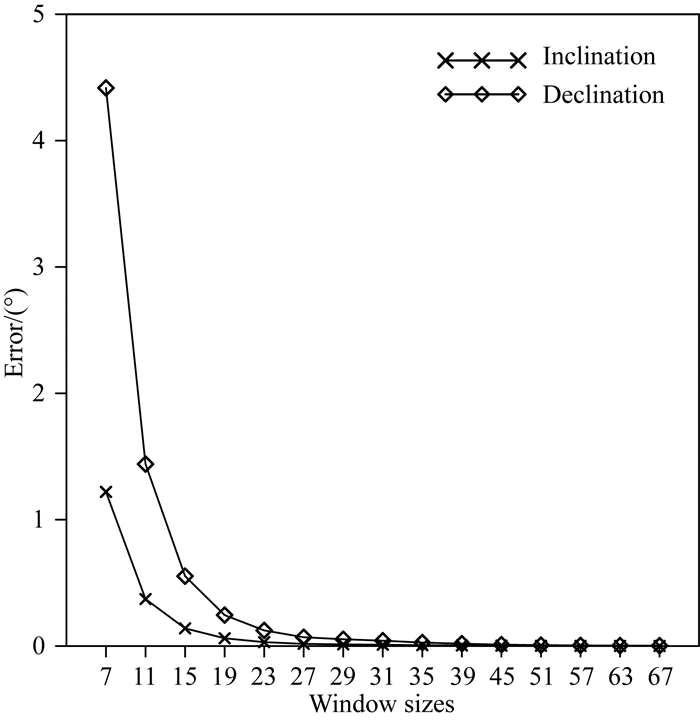
|
图 1 不同窗口大小估算的总磁化方向误差 Fig. 1 Error of total magnetization direction estimation with different window sizes |
采用单模型数据,分析磁化偏角、磁化倾角等值线图以及角度差值等值线图的特征,并分析在不同磁化倾角下,估算的磁化偏角、磁化倾角与实际磁源中心的位置关系.设置模型为边长1000 m的立方体,顶面埋深300 m,磁化率0.05SI,地磁场强度50000 nT,地磁偏角0.67°,地磁倾角61.5°,观测面离地高度300 m.设置了多个总磁化方向(表 1),涵盖了中、高、低倾角及各象限的磁化偏角.为了验证算法对含噪声数据的效果,在模型数据中加入了标准差为数据最大绝对值2%的高斯噪声.根据滑动窗口大小选择的分析,由于模型参数相同,我们选取大小为25、27、31的网格窗口进行计算.为了突出磁源中心,角度差值图实际显示差值的倒数,则差值最大处即为磁源中心位置.在计算倒数时,可能存在分母为零的情况,若为零则将该倒数赋为一个很大的值.分母为零说明各窗口在该位置的计算结果相同,该位置很可能是磁源中心的实际位置.由于采用滑动窗口,当窗口中心偏离磁源中心时,计算的偏角或倾角既可能为正值也可能为负值,这是由于积分窗口中心偏离实际磁源中心所造成的.
|
|
表 1 单一模型总磁化方向估算结果 Table 1 Total magnetization direction estimation results of single model |
估算结果显示(图 2—图 6,表 1),对于单一模型数据而言,估算的总磁化方向误差较小.进一步分析磁化倾角、磁化偏角等值线图特征与磁源中心位置,我们得出以下关系:
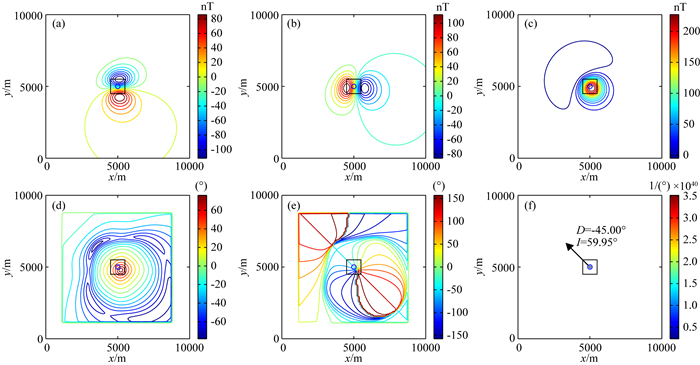
|
图 2 单一模型(D=-45°, I=60°)总磁化方向估算结果 (a) Bx; (b) By; (c) Bz; (d) 磁化倾角; (e) 磁化偏角; (f) 角度差值倒数及估算结果. Fig. 2 Total magnetization direction estimation result of single model (D=-45°, I=60°) (a) Bx; (b) By; (c) Bz; (d) Inclination; (e) Declination; (f) Reciprocal of angular difference and estimation result. |
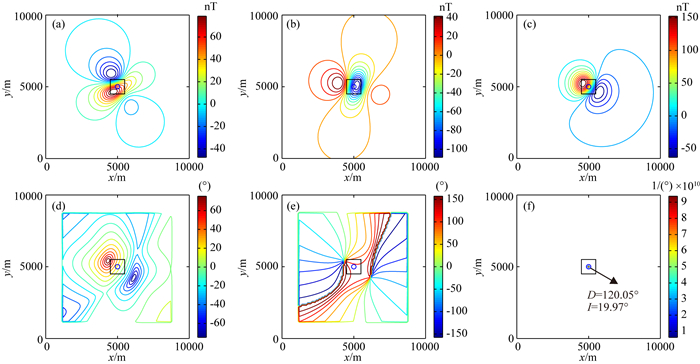
|
图 3 单一模型(D=120°, I=20°)总磁化方向估算结果 (a) Bx; (b) By; (c) Bz; (d) 磁化倾角; (e) 磁化偏角; (f) 角度差值倒数及估算结果. Fig. 3 Total magnetization direction estimation result of single model (D=120°, I=20°) (a) Bx; (b) By; (c) Bz; (d) Inclination; (e) Declination; (f) Reciprocal of angular difference and estimation result. |

|
图 4 单一模型(D=-100°, I=0°)总磁化方向估算结果 (a) Bx; (b) By; (c) Bz; (d) 磁化倾角; (e) 磁化偏角; (f) 角度差值倒数及估算结果. Fig. 4 Total magnetization direction estimation result of single model (D=-100°, I=0°) (a) Bx; (b) By; (c) Bz; (d) Inclination; (e) Declination; (f) Reciprocal of angular difference and estimation result. |

|
图 5 单一模型(D=10°, I=-15°)总磁化方向估算结果 (a) Bx; (b) By; (c) Bz; (d) 磁化倾角; (e) 磁化偏角; (f) 角度差值倒数及估算结果. Fig. 5 Total magnetization direction estimation result of single model (D=10°, I=-15°) (a) Bx; (b) By; (c) Bz; (d) Inclination; (e) Declination; (f) Reciprocal of angular difference and estimation result. |
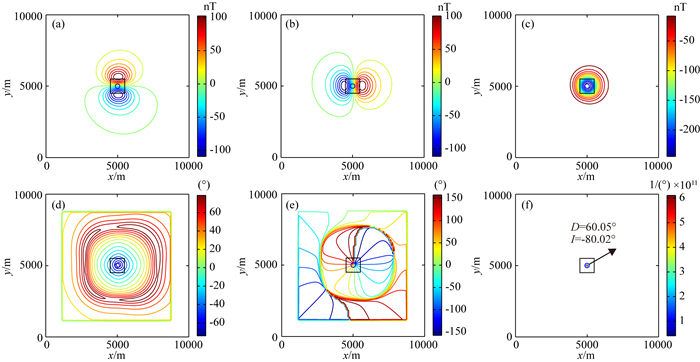
|
图 6 单一模型(D=60°, I=-80°)总磁化方向估算结果 (a) Bx; (b) By; (c) Bz; (d) 磁化倾角; (e) 磁化偏角; (f) 角度差值倒数及估算结果. Fig. 6 Total magnetization direction estimation result of single model (D=60°, I=-80°) (a) Bx; (b) By; (c) Bz; (d) Inclination; (e) Declination; (f) Reciprocal of angular difference and estimation result. |
(1) 磁化偏角等值线图:当磁化倾角较大时,磁化偏角等值线图有一个汇聚点(图 2e、图 6e),磁源中心位于汇聚点附近;当磁化倾角较小时,磁化偏角等值线图有两个汇聚点(图 3e、图 4e、图 5e),磁源中心位于两汇聚点连线上.
(2) 磁化倾角等值线图:当磁化倾角较大时,磁源中心位于磁化倾角等值线图的极值点附近(图 2d、图 6d);当磁化倾角较小时,磁源中心位于磁化倾角等值线图的正负极值之间,且磁源的磁化偏角方向由正极值指向负极值(图 3d、图 4d、图 5d).
通过上述关系,可根据估算的磁化倾角、磁化偏角等值线图,综合判断磁源中心的位置,并结合角度差值确定磁化方向.特别是对于多异常相互影响,而使得角度差值的结果无法确定磁源中心时,根据上述关系进行综合分析,采取缩小范围的方法,限定角度差值区域来确定磁源中心的位置,从而获得最终的估算结果.
2 双模型数据试验为了进一步验证方法的有效性,采用双模型数据进行试验.设置的两个模型的形态大小、埋深及磁化率等参数同单一模型,总磁化方向分别为:模型A的磁化偏角为30°,磁化倾角为50°;模型B的磁化偏角为60°,磁化倾角为-60°.地磁场强度50000 nT,地磁偏角0.67°,地磁倾角61.5°.
双模型数据的估算结果显示(图 7f),由于受到相邻异常的影响,角度差值的最小值并不在磁源的实际中心位置,因此需要限定区域,根据磁化倾角、磁化偏角及角度差值等值线图的特征进行位置的综合估算.对角度差值倒数图取对数(图 8a),结果显示,在磁源中心出现了局部极值点,与模型实际中心吻合.对磁源位置进行约束,即只求取并限制磁源中心附近的极值点,结果显示(图 8b),估算的位置与实际吻合,估算的总磁化方向误差较小,分别为:模型A的磁化偏角为29.45°,磁化倾角为50.01°;模型B的磁化偏角为59.63°,磁化倾角为-60.11°.因此,对于多异常而言,同样可以取得较好的估算结果.但是,如果两个异常相邻过近,造成磁化偏角等值线图无法形成标准的汇聚点,则无法估算总磁化方向.当异常有叠加时,可将叠加的异常分离后,再采用本方法进行估算.

|
图 7 双模型(A: D=30°, I=50°; B: D=60°, I=-60°)总磁化方向估算结果(限制区域前) (a) Bx; (b) By; (c) Bz; (d) 磁化倾角; (e) 磁化偏角; (f) 角度差值倒数及估算结果. Fig. 7 Total magnetization direction estimation result of two models(A: D=30°, I=50°; B: D=60°, I=-60°) before area limiting (a) Bx; (b) By; (c) Bz; (d) Inclination; (e) Declination; (f) Reciprocal of angular difference and estimation result. |

|
图 8 双模型(A: D=30°, I=50°; B: D=60°, I=-60°)总磁化方向估算结果(限制区域后) (a) 角度差值倒数对数; (b) 角度差值倒数及估算结果. Fig. 8 Total magnetization direction estimation result of two models(A: D=30°, I=50°; B: D=60°, I=-60°) after area limiting (a) Log map of reciprocal of angular difference; (b) Reciprocal of angular difference and estimation result. |
中国自然资源航空物探遥感中心于2018年在东天山启鑫地区对AGS-863航磁三分量测量系统进行了试验飞行,共获得约10897测线千米的实测航磁三分量数据,测线沿155°和335°方向飞行,线距500 m,平均飞行高度300 m(Xie et al., 2020).测区中心的地磁偏角为0.67°,地磁倾角为61.5°.实测数据经过补偿及校准后,利用姿态测量系统测量的姿态角,将飞机机体坐标系下的三分量数据转换成地理坐标系下的三分量数据,并进行了正常地磁场校正(图 9)(Xie et al., 2020).图 9a、图 9d中的ΔT及垂向分量的南部(方框内)为一个典型的负异常,是启鑫岩体的磁异常反映.若岩体没有剩磁,在北半球的中高纬度地区,ΔT及垂向分量通常表现为南正北负的特征,北向分量表现为南正北负,东向分量表现为东负西正.由于该岩体具有剩磁,其ΔT及垂向分量整体表现为负异常,北向分量表现为南负北正,东向分量表现为东正西负.
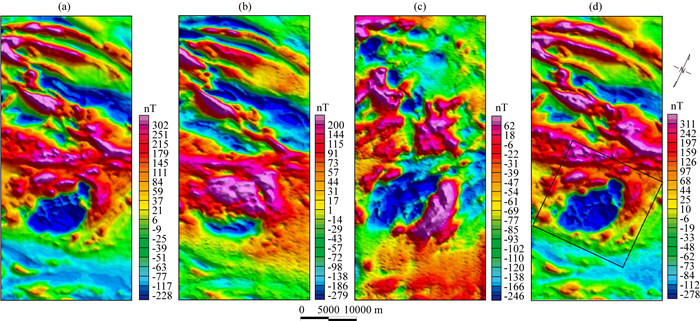
|
图 9 东天山启鑫地区实测航磁ΔT及航磁三分量(据Xie et al., 2020) (a) ΔT; (b) Bx; (c) By; (d) Bz. Fig. 9 Measured total magnetic field ΔT and three-component data at the Qixin area of the East Tianshan Mountains (after Xie et al., 2020) |
启鑫岩体磁异常较复杂,由一个主体异常(异常M)及其他次级异常组成(图 10),相互之间存在影响,对估算的结果具有一定影响.为了增加估算结果的可靠性,我们选取不同的窗口(窗口组合见表 2)求取平均值作为最终的估算结果,并根据磁化倾角、磁化偏角及角度差值倒数等值线图的特征进行位置的综合估算.结果显示(表 2),该岩体主体异常(异常M)的平均总磁化偏角为33.4°,平均总磁化倾角为-81.0°.野外采集岩石的剩磁测定结果表明,启鑫岩体中的岩石具有较强的剩磁,其中,辉长岩是该岩体的主要岩石之一,剩余磁化倾角主要范围在-15°至-75°之间,负磁化倾角最大值为-86.7°,剩余磁化偏角从17°到351°皆有分布.由于总磁化方向是感应磁化方向与剩余磁化方向的矢量和,且估算的总磁化方向为岩体整体磁化的反映,估算结果可作为野外剩磁测定结果的补充,并可用于反演及解释中.
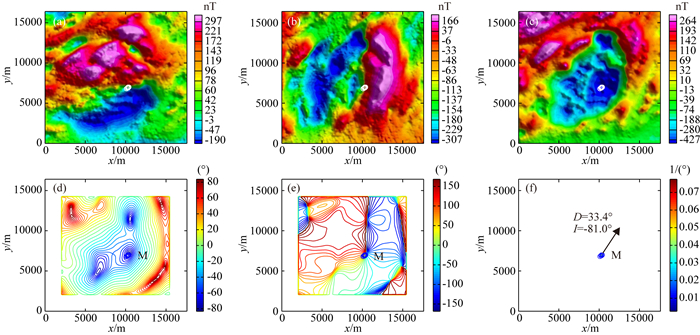
|
图 10 启鑫岩体总磁化方向估算结果(图中圆圈为5次估算的异常中心) (a) Bx; (b) By; (c) Bz; (d) 磁化倾角; (e) 磁化偏角; (f) 角度差值倒数及估算结果. Fig. 10 Total magnetization direction estimation result of the Qixin Rock (The circle is the anomaly center of the five estimation results) (a) Bx; (b) By; (c) Bz; (d) Inclination; (e) Declination; (f) Reciprocal of angular difference and estimation result. |
|
|
表 2 启鑫岩体总磁化方向估算结果 Table 2 Total magnetization direction estimation results of the Qixin Rock |
获得估算的总磁化方向后,可用于磁异常的化极计算.传统的化极假设地质体无剩磁,化极所用的总磁化方向为正常地磁场方向,因此在地质体具有剩磁的情况下会造成错误的结果.分别采用估算的总磁化方向(总磁化偏角33.4°,总磁化倾角-81.0°) 以及当地正常地磁场的磁化方向(地磁偏角0.67°,地磁倾角61.5°)进行化极计算,化极结果分别见图 11a、图 11b.由于磁异常模量(图 11c)受磁化方向的影响较小(Li et al., 2010),其特征与化极结果具有一定相似性.对比表明,采用估算总磁化方向的化极结果显示,启鑫岩体整体表现为正异常(白色线为M异常位置),与磁异常模量类似,而采用当地正常地磁场方向的化极结果则明显存在错误,即M异常仍整体表现为负异常.

|
图 11 (a) 估算总磁化方向的化极结果及(b)当地地磁场方向的化极结果与(c)磁异常模量对比 白色线为M异常位置. Fig. 11 Comparison between (c) magnetic amplitude and the results of reduction to the magnetic pole using (a) the estimated total magnetization direction and (b) the local geomagnetic direction The white line indicates the location of the M anomaly. |
基于三分量磁异常一阶矩与磁源磁矩积分关系,分析了在不同磁化倾角下,估算的磁化偏角、磁化倾角与实际磁源中心的位置关系.当磁化倾角较大时,磁源中心位于磁化偏角的汇聚点附近,且位于磁化倾角的极值点附近;当磁化倾角较小时,磁源中心位于磁化偏角两汇聚点连线上,且位于磁化倾角正负极值之间,磁源磁化偏角的方向由正极值指向负极值.
针对该方法易受相邻异常影响,使得多异常的估算难于获取磁源中心位置的问题,通过限定角度差值区域,获得了多异常情况下的总磁化方向估算结果.首次航磁三分量数据总磁化方向估算结果以及化极计算表明,该方法可获得较可靠的总磁化方向以及磁源中心位置估算结果.由于本方法假设磁源为均匀磁化,而实际地质体具有复杂的磁化特征,往往具有不均匀性,因此本方法的估算结果应视为地质体总磁化方向的整体体现,在实际应用中应注意.
致谢 衷心感谢两位匿名审稿专家提出中肯而具建设性的修改意见.中国自然资源航空物探遥感中心周德文、郭亮、邓肖丹、王启、梁秀娟、梁韧、李芳等承担了航磁三分量测量系统试验飞行中的重要内容,何敬梓提供了辉长岩剩磁测定结果,在此一并表示衷心感谢.
Behura J. 2020. Geophysics bright spots. The Leading Edge, 39(8): 597. DOI:10.1190/tle39080597.1 |
Blakely R J. 1995. Potential Theory in Gravity and Magnetic Applications. Cambridge: Cambridge University Press.
|
Caratori Tontini F, Pedersen L B. 2008. Interpreting magnetic data by integral moments. Geophysical Journal International, 174: 815-824. DOI:10.1111/j.1365-246X.2008.03872.x |
Dannemiller N, Li Y G. 2006. A new method for determination of magnetization direction. Geophysics, 71(6): L69-L73. DOI:10.1190/1.2356116 |
Foss C, McKenzie B. 2011. Inversion of anomalies due to remanent magnetisation: an example from the Black Hill Norite of South Australia. Australian Journal of Earth Sciences, 58(4): 391-405. DOI:10.1080/08120099.2011.581310 |
Gerovska D, Araúzo-Bravo M J, Stavrev P. 2009. Estimating the magnetization direction of sources from southeast Bulgaria through correlation between reduced-to-the-pole and total magnitude anomalies. Geophysical Prospecting, 57(4): 491-505. DOI:10.1111/j.1365-2478.2008.00761.x |
Guan Z N, Li B G. 1984. The integral and iteration techniques for calculation of the total magnetic moment and the position of the center of the magnetic disturbing body. Chinese Journal of Geophysics (Acta Geophysica Sinica) (in Chinese), 27(5): 483-494. |
Guo L H, Gao R, Zhang G L. 2014. Estimating the magnetization direction of sources through correlation between reduced-to-pole anomaly and normalized source strength. Applied Mechanics and Materials, 644-650: 3793-3796. DOI:10.4028/www.scientific.net/AMM.644-650.3793 |
Guo Z H, Guan Z N, Xiong S Q. 2004. Cuboid ΔT and its gradient forward theoretical expressions without analytic odd points. Chinese Journal of Geophysics (in Chinese), 47(6): 1131-1138. |
Helbig K. 1963. Some integrals of magnetic anomalies and their relation to the parameters of the disturbing body. Zeitschrift für Geophysik, 29: 83-96. |
Li S L, Li Y G. 2014. Inversion of magnetic anomaly on rugged observation surface in the presence of strong remanent magnetization. Geophysics, 79(2): J11-J19. DOI:10.1190/geo2013-0126.1 |
Li Y G, Shearer S E, Haney M M, et al. 2010. Comprehensive approaches to 3D inversion of magnetic data affected by remanent magnetization. Geophysics, 75(1): L1-L11. DOI:10.1190/1.3294766 |
Li Y G. 2017. From susceptibility to magnetization: Advances in the 3D inversion of magnetic data in the presence of significant remanent magnetization. //Tschirhart V, Thomas M D. Proceedings of Exploration 17: Proceedings of the Sixth Decennial International Conference on Mineral Exploration. Toronto, Canada, 239-260.
|
Li Y Y, Yang Y S, Liu T Y. 2010. Magnetic forward and reverse modelling of 3D bodies of arbitrary shape with consideration of demagnetization: progress and prospect. Progress in Geophysics (in Chinese), 25(2): 627-634. DOI:10.3969/j.issn.1004-2903.2010.02.036 |
Lin J, Diao S, Zhang Y, et al. 2017. Research progress of geophysical vector magnetic field survey technology. Chinese Science Bulletin (in Chinese), 62(23): 2606-2618. DOI:10.1360/N972017-00010 |
Liu S, Liu T Y, Gao W L, et al. 2012. The influence of demagnetization on magnetic data interpretation. Geophysical and Geochemical Exploration (in Chinese), 36(4): 602-606. |
Liu S, Feng J, Gao W L, et al. 2013. 2D inversion for borehole magnetic data in the presence of significant remanence and demagnetization. Chinese Journal of Geophysics (in Chinese), 56(12): 4297-4309. DOI:10.6038/cjg20131232 |
Liu S, Hu X Y, Xi Y F, et al. 2015. 2D sequential inversion of total magnitude and total magnetic anomaly data affected by remanent magnetization. Geophysics, 80(3): K1-K12. DOI:10.1190/geo2014-0019.1 |
Lourenco J S, Morrison H F. 1973. Vector magnetic anomalies derived from measurements of a single component of the field. Geophysics, 38(2): 359-368. DOI:10.1190/1.1440346 |
Luo Y, Yao C L. 2007. Theoretical study on cuboid magnetic field and gradient expression without singular point. Oil Geophysical Prospecting (in Chinese), 42(6): 714-719. |
Munschy M, Fleury S. 2010. Scalar, vector, tensor magnetic anomalies: Measurement or computation?//EGM 2010 International Workshop: Adding New Value to Electromagnetic, Gravity and Magnetic Methods for Exploration. Capri, Italy.
|
Nicolosi I, Blanco-Montenegro I, Pignatelli A, et al. 2006. Estimating the magnetization direction of crustal structures by means of an equivalent source algorithm. Physics of the Earth and Planetary Interiors, 155(1-2): 163-169. DOI:10.1016/j.pepi.2005.12.003 |
Phillips J D. 2005. Can we estimate total magnetization directions from aeromagnetic data using Helbig's formulas?. Earth, Planets and Space, 57(8): 681-689. DOI:10.1186/BF03351848 |
Phillips J D, Nabighian M N, Smith D V, et al. 2007. Estimating locations and total magnetization vectors of compact magnetic sources from scalar, vector, or tensor magnetic measurements through combined Helbig and Euler analysis. //SEG 2007 Annual Meeting, San Antonio, USA. 770-774.
|
Pilkington M, Beiki M. 2013. Mitigating remanent magnetization effects in magnetic data using the normalized source strength. Geophysics, 78(3): J25-J32. DOI:10.1190/geo2012-0225.1 |
Roest W R, Pilkington M. 1993. Identifying remanent magnetization effects in magnetic data. Geophysics, 58(5): 653-659. DOI:10.1190/1.1443449 |
Wang M Y, Di Q Y, Xu K, et al. 2004. Magnetization vector inversion equations and 2D forward and inversed model study. Chinese Journal of Geophysics (in Chinese), 47(3): 528-534. |
Xie R K, Xiong S Q, Duan S L, et al. 2020. Noise estimation in vector magnetic data derived from airborne vector magnetic system. Geophysics, 85(4): J71-J83. DOI:10.1190/geo2019-0663.1 |
Xiong S Q, Zhou X H, Xue D J, et al. 2018. Theory Technology Method Instruments and Application of Comprehensive Airborne Geophysical Exploration (in Chinese). Beijing: Geological Publishing House.
|
Xiong S Q. 2020. Innovation and application of airborne geophysical exploration technology. Journal of Geomechanics (in Chinese), 26(5): 791-818. |
Zhang H L, Ravat D, Marangoni Y R, et al. 2018. Improved total magnetization direction determination by correlation of the normalized source strength derivative and the reduced-to-pole fields. Geophysics, 83(6): J75-J85. DOI:10.1190/geo2017-0178.1 |
管志宁, 李保国. 1984. 用积分与迭代方法反演磁性地质体的总磁矩及其中心位置. 地球物理学报, 27(5): 483-494. DOI:10.3321/j.issn:0001-5733.1984.05.009 |
郭志宏, 管志宁, 熊盛青. 2004. 长方体ΔT场及其梯度场无解析奇点理论表达式. 地球物理学报, 47(6): 1131-1138. DOI:10.3321/j.issn:0001-5733.2004.06.029 |
李媛媛, 杨宇山, 刘天佑. 2010. 考虑自退磁影响的三维复杂形体磁场正反演研究进展与展望. 地球物理学进展, 25(2): 627-634. DOI:10.3969/j.issn.1004-2903.2010.02.036 |
林君, 刁庶, 张洋, 等. 2017. 地球物理矢量场磁测技术的研究进展. 科学通报, 62(23): 2606-2618. |
刘双, 刘天佑, 高文利, 等. 2012. 退磁作用对磁测资料解释的影响. 物探与化探, 36(4): 602-606. |
刘双, 冯杰, 高文利, 等. 2013. 强剩磁强退磁条件下的二维井中磁测反演. 地球物理学报, 56(12): 4297-4309. DOI:10.6038/cjg20131232 |
骆遥, 姚长利. 2007. 长方体磁场及其梯度无解析奇点表达式理论研究. 石油地球物理勘探, 42(6): 714-719. DOI:10.3321/j.issn:1000-7210.2007.06.019 |
王妙月, 底青云, 许琨, 等. 2004. 磁化强度矢量反演方程及二维模型正反演研究. 地球物理学报, 47(3): 528-534. DOI:10.3321/j.issn:0001-5733.2004.03.025 |
熊盛青, 周锡华, 薛典军, 等. 2018. 航空地球物理综合探测理论技术方法装备应用. 北京: 地质出版社.
|
熊盛青. 2020. 航空地球物理勘查科技创新与应用. 地质力学学报, 26(5): 791-818. |
 2021, Vol. 64
2021, Vol. 64


